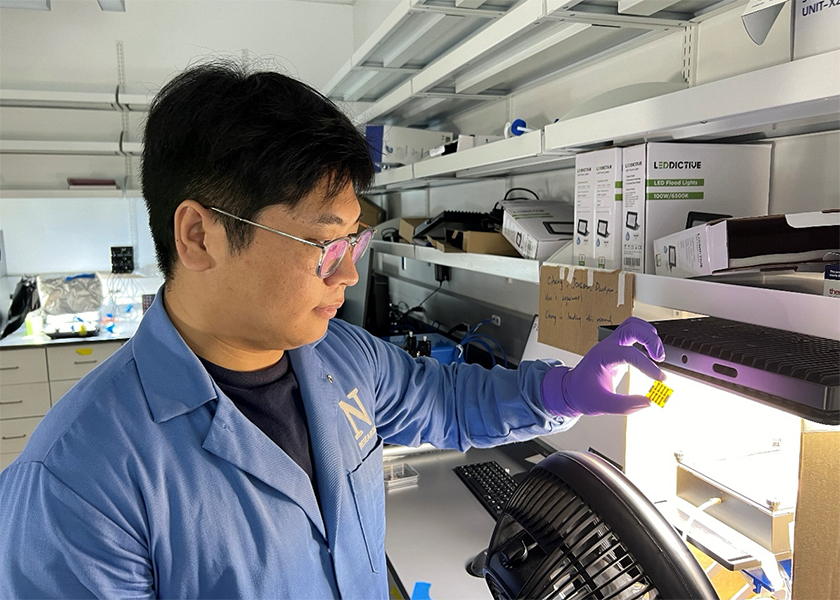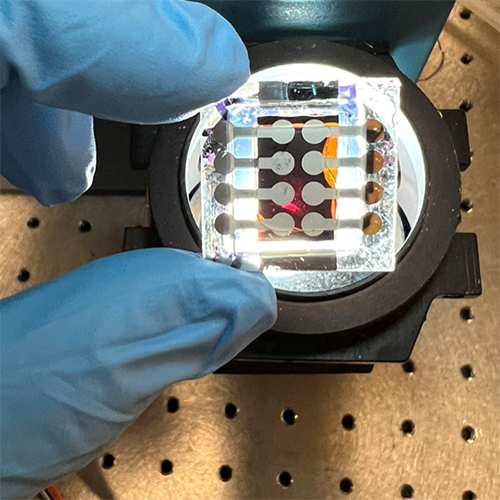The Problem
Perovskite solar cells offer a rapid increase in efficient power conversion but still suffer from stability issues.
Perovskite solar cells offer a rapid increase in efficient power conversion but still suffer from stability issues.
The addition of diamine to improve the perovskite solar cell’s surface.
The process made the surface more stable and improved the overall performance, resulting in a power conversion efficiency of 27.4 percent with better stability.
Postdoctoral Researcher Chongwen Li, Research Associate Professor Bin Chen, Professor Mercouri Kanatzidis, Professor Ted Sargent
Northwestern Engineering researchers have developed a new strategy to stabilize and perfect mixed tin-lead perovskite surfaces for efficient and stable all-perovskite tandem solar cells.
A novel thin-film technology, perovskite solar cells present a rapid increase in efficient power conversion but still suffer from stability issues. This new method could mark a step toward perovskite solar cells’ wide usage to provide green energy.
“Our work presents an effective strategy to improve the durability of this new photovoltaic technology, accelerating the practical application and commercialization of perovskite solar cells,” said Chongwen Li, a postdoctoral researcher in the lab of Professor Ted Sargent.

Li presented his work in the paper “Diamine Chelates for Increased Stability in Mixed Sn–Pb and All-Perovskite Tandem Solar Cells,” published Aug. 15 in the journal Nature Energy. Sargent is the Lynn Hopton Davis and Greg Davis Professor of Chemistry and professor of electrical and computer engineering at Northwestern Engineering, and co-executive director of the Paula M. Trienens Institute for Sustainability and Energy.
Sargent’s group has made great strides toward making pure-lead perovskites a viable green power source. Li’s method is conceptually different, however, than past studies. This investigation used diamine chelation chemistry targeting tin-containing perovskite, where a metal ion forms a stable bond with a molecule that has two nitrogen atoms holding the metal in place. The method is new to the field of perovskite solar cells.

And while previous work from Sargent’s group has tried to lessen perovskite surface defects, this time the researchers created partially non-conductive and non-functional areas that protect the perovskite area underneath from becoming defective.
In this work, the team used a new chemical method to improve the perovskite solar cell’s surface. By adding diamine to the surface, Li removed extra tin and adjusted the tin-to-lead ratio to be more balanced. The diamine also created a stable barrier layer that helps protect the surface from atmospheric oxygen and heat. This process made the surface more stable and improved the overall performance, resulting in a power conversion efficiency of 27.4 percent with better stability.
“Our diamine chelation strategy effectively suppresses the oxidation and prolongs operational stability. This is because diamine chelation forms high-resistive barriers, similar to the passivated emitter rear contact structure used in silicon solar cells,” research associate professor Bin Chen said. “These high-resistive barriers provide a novel and effective passivation mechanism for stabilizing and perfecting mixed tin-lead and all-perovskite tandem solar cells, moving this technology closer to commercialization.”
This work was completed through collaboration with the University of Toronto, University of Toledo, University of Washington, King Abdullah University of Science and Technology (KAUST), Lawrence Berkeley National Laboratory, University of Massachusetts Amherst, Georgia Institute of Technology, and Tohoku University.